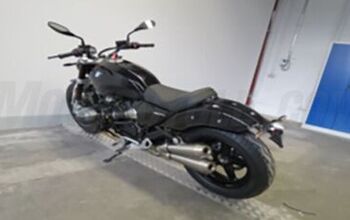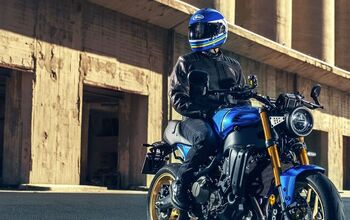Road Racing Series - Part 11
It's a three-and-a-half hour drive home from Virginia International Raceway. Just enough time for my blood to stop boiling from such a lousy performance and to give me a chance to reflect on this entire project and the mistakes I had made.
“Believe it or not, your first-race experience isn't really uncommon,” Editor-In-Chief Duke offered on the Monday after. “Despite best intentions, a first race is always fraught with tension and some measure of unpreparedness for the entire experience. Although your back-of-the-pack finishes aren't what you'd hoped for, they are much preferable to wadding up your bike in the hapless pursuit of initial glory. Your next race weekend will undoubtedly go much smoother, leaving your mind free to explore where you can trim chunks off your lap times.”
This series was introduced as the "The 'How Not To' Guide to Getting Started in Road Racing." Here are some lessons learned, some things that I would do different the second time around, a heads-up for those preparing to race so they can hopefully avoid the mistakes I made:
1. Choose a smaller, underpowered motorcycle as your first race bike. Using a 600cc four-cylinder Supersport motorcycle puts you in the most crowded and competitive class on the track. These models are updated every two years, so a three-year-old motorcycle is getting long in the tooth. The eight-year-old 748 we built was a Roman chariot. Not only are these models falling off manufacturer’s contingency requirement, the availability of aftermarket performance parts is beginning to wane. Many companies wanted to support our project, they just weren't making parts for the 748 anymore. Many of the parts I used are no longer available new and had to be scrounged through used outlets.
On the other hand, entry-level machines are updated much less frequently: a 2009 Suzuki SV650 is virtually identical to a 2003 model. This means there is a glut of used parts lying around and performance catalogs stocked full of parts that fit your model. Two cylinders are less complex and cheaper when something goes wrong, and the start-up costs of building the motorcycle are lower.
These bikes also drop you from middleweight to lightweight classes and put you in the company of more beginning racers like yourself.
2. Plan to have your bike build completed one month before you take it to the track. In reality it might be finished two or three days early, which means you'll get two or three good nights sleep before you hit the track for the first time. Don't underestimate the value of being physically and mentally prepared for your first race. A well rested and physically prepared body will get you closer to the podium than the best motorcycle.
3. Plan to run a half-dozen track days before your first race. "It takes guts to try and race when it's only your second time on a track," some of my fellow racers said. Maybe that was their nice way of saying, "You're an idiot." If you get started in the spring, by mid-summer you'll be ready to race with half of the season left. This is especially important if you're planning to race a bike that has become a racer after years of serving as a commuter. The track days will give you a few chances to get reacquainted with the feel, handling and performance of the "new" machine and a chance to work out any kinks, problems or bugs before you're under the gun and staring at the green flag.
“Changing all the parts you did on your bike was the likely reason you went slower,” Duke said. “The bike changed from what you knew, so it felt different, and different is often perceived of as worse. I'm sure you'll go quicker with more setup time and greater familiarity.”
I sure hope so…
An Eye Towards the Future
Those with a keen eye will notice that some of the parts we showcased in our build articles don't show up in the photos of our race weekend. Several parts, including the Brembo braking components, the STM slipper clutch, the Scotts steering damper and the Factory Pro shift kit did not arrive until after our first race. As soon as we can get back out to the track, we'll be out testing these new additions, trying to figure out the true potential of the machine we built and reporting back to our readers.
And this next time we're racing, we hope to see you there too.
I’d like to thank the following people, without whose help I never would have made it to my first checkered flag:
Holly, my dad, and the rest of my family.
Donnie Unger and Duc Pond Motorsports
Aaron Stevenson and all the instructors at Cornerspeed Riders School
Jeff Gagliano, Rick Ruelle and Mario Samala of Phillips Motorsport Group ( Lockhart Phillips)
Peter Jones and Christoph Knoche of Metzeler/Pirelli
Caroline Fallara and Claudio Teoldi of Brembo Performance SPA and Brembo North America
Nicholas J. Iannitti and STM Italy
Erick Hilton and Race Tech
Mary and Sharkskinz
Arman Sarkissian and Corsa Velocita LLC, Mad Duc
Christian Hansen and SpeedyMoto
Brian Kelley and Regina USA
Uri Thatcher and ColorRite Distributing, Inc.
Nelson Yee and Dynojet Research/ Power Commander
Scott Forward and Scotts Performance
Eraldo Ferracci and Fast by Ferracci
Steve Scheidker and VP Racing Fuel
David Podolsky and Chicken Hawk Racing
Bruce Ash and Yuasa Battery, Inc.
Marc Salvisberg and Factory Pro
Dante DelGrosso and Vortex Racing Components
Daniel and New Enough
Scott Goodwin of G-Forces Marketing and HJC
Dave Molinari and Stomp Design
Eric Wood and Woodcraft CFM
Jim Hoover and Broadway Metal Works
Eric Kelcher and CCS racing
Geoff May
Kevin Duke of Motorcycle.com and Joe Magro of VerticalScope
Related Reading
Road Racing Series - Part 1
Road Racing Series - Part 2
Road Racing Series - Part 3
Road Racing Series - Part 4
Road Racing Series - Part 5
Road Racing Series - Part 6
Road Racing Series - Part 7
Road Racing Series - Part 8
Road Racing Series - Part 9
Road Racing Series - Part 10
More by Jeremiah Knupp



























Comments
Join the conversation